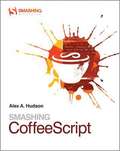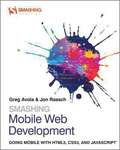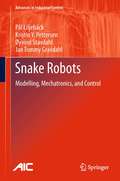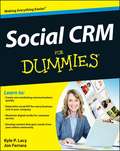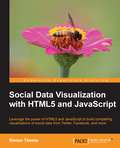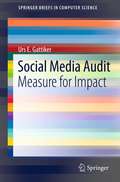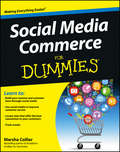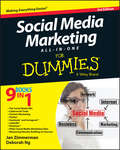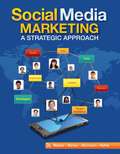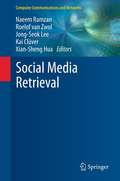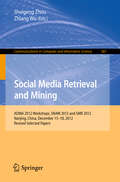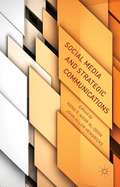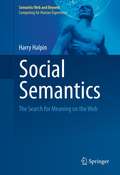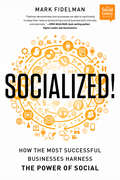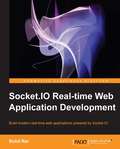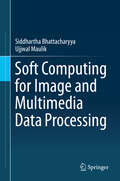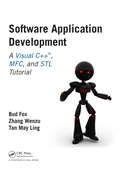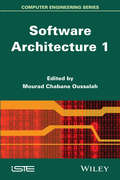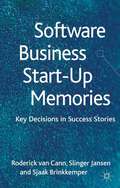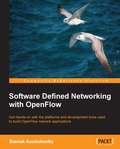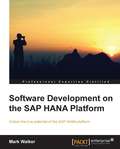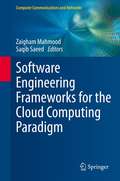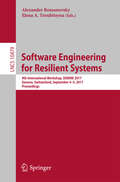- Table View
- List View
Smashing CoffeeScript
by Alex HudsonBrew the perfect code with CoffeeScriptIf you're familiar with JavaScript and the often-frustrating process of creating complex applications, a nice cup of CoffeeScript can help. CoffeeScript is a programming language that compiles into JavaScript and simplifies the entire development process. Now you can tap the full power of CoffeeScript with Smashing CoffeeScript. This full-color, practical book explains CoffeeScript language, syntax, and processes, and will soon have you producing concise and quality code. Ultimately, you'll create RIAs and mobile apps faster, with less hassle.Gets developers up and running on CoffeeScript, a programming language that compiles into JavaScript and simplifies the process of building softwareHelps you produce better JavaScript and more quicklyIntroduces the language, syntax, and processes of CoffeeScriptCovers the development of both mobile and rich internet appsExplores the HTML5 feature set, real-time communication, and using CoffeeScript within node.js projectsDevelopers, blend some better JavaScript with CoffeeScript and Smashing CoffeeScript.
Smashing Mobile Web Development
by G. Avola Jon RaaschDevelopers, here's what you need to migrate your skills to mobileIf you're a devoted reader of Smashing Magazine, you know that all development roads now lead to mobile, so desktop-browser-based web developers need to get up to speed and soon. Start migrating your abilities to mobile with this terrific book. It first helps you make the switch to HTML5 and CSS3, before teaching you how to apply those skills to build websites that work across all mobile devices and mobile browsers.Topics include using wireframes and templates, understanding frameworks such as jQuery Mobile, getting up to speed on newer technologies such as Boilerplate, and more.Essential guide for web developers who want to build websites that work across all mobile devices and mobile browsersExplains the essential tools you'll need for web mobile, including HTML5, CSS3, and JQuery MobileBrings you up to speed on newer tools such as BoilerplateKeeps your professional skills up to date with today's technology trendsBy the time you finish Smashing Mobile Web Development, you'll have built your own mobile website that incorporates geolocation, social media, and more.
Snake Robots
by Kristin Y. Pettersen Øyvind Stavdahl Jan Tommy Gravdahl Pål LiljebäckSnake Robots is a novel treatment of theoretical and practical topics related to snake robots: robotic mechanisms designed to move like biological snakes and able to operate in challenging environments in which human presence is either undesirable or impossible. Future applications of such robots include search and rescue, inspection and maintenance, and subsea operations. Locomotion in unstructured environments is a focus for this book. The text targets the disparate muddle of approaches to modelling, development and control of snake robots in current literature, giving a unified presentation of recent research results on snake robot locomotion to increase the reader's basic understanding of these mechanisms and their motion dynamics and clarify the state of the art in the field. The book is a complete treatment of snake robotics, with topics ranging from mathematical modelling techniques, through mechatronic design and implementation, to control design strategies. The development of two snake robots is described and both are used to provide experimental validation of many of the theoretical results. Snake Robots is written in a clear and easily understandable manner which makes the material accessible by specialists in the field and non-experts alike. Numerous illustrative figures and images help readers to visualize the material. The book is particularly useful to new researchers taking on a topic related to snake robots because it provides an extensive overview of the snake robot literature and also represents a suitable starting point for research in this area.
Social CRM For Dummies
by Stephanie Diamond Kyle Lacy Jon FerraraDiscover great ways to engage your customers through the social webSocial CRM is an evolving tool to help you engage your customers, interact with them, and develop deeper relationships. This handy guide teaches you how to make the most of it, whether your business is a small shop or a large corporation. In a friendly, easy-to-understand style, it explains how you can create new marketing communications and develop smart, applicable content that produces results from your online community. You'll learn to use data to drive results, create social Key Performance Indicators for different business units, and a great deal more.Today's consumer uses technology to select relationships with companies; this book teaches business owners how to use social CRM to create relationships that customers want to maintainExplains how to integrate social media into your CRM mix Shows how to use data and information gathered through social sites Helps you develop social KPIs and create content that gets results from your online communitySocial CRM For Dummies helps businesses large and small use social media to develop and maintain productive customer relationships.
Social Data Visualization with HTML5 and JavaScript
by Simon TimmsThis book is a fast-paced guide full of step-by-step instructions that teach you how to visualize social data using HTML5 and JavaScript.This book is for developers who are excited about data and who want to share that excitement with others. Developers who are interested in the data which can be extracted from social networks will also find this book hugely beneficial.Readers should have a working knowledge of both JavaScript and HTML.
Social Media Audit
by Urs E. GattikerSocial media has drastically improved the way we can reach target audiences and serve our customers. Like its financial counterpart, the social media audit (SMA) can be described as a formalized review of anorganization's social media activities. However, contrary to financial audits, social media audits are not guided by government regulations or a set of professional rules and standards. This book will address social media marketing issues using a cost benefit approach, while presenting a systematic approach to review the organization's social media activities. Using the checklists and templates provided in this book will enable readers to conduct an audit that helps identify target areas for performance improvement and recommendations for how to achieve these objectives. Social media platforms discussed include: Facebook, LinkedIn, Google Plus, Twitter, Tumblr, and Xing.
Social Media Commerce For Dummies
by Marsha CollierCapture customers and sales with social media commerceSocial media commerce is a booming industry. By using social networks in the context of e-commerce transactions, brands large and small are making their products more available and more convenient for customers. This one-of-a-kind guide introduces you to social media commerce and explains how you can use social media to provide better customer service, collect payments online, and build your customer base. Online marketing expert Marsha Collier helps you determine where you have the best opportunity to reach your market, which sites you should integrate with, and much more.Your customers are communicating with each other via social media; making purchasing opportunities available on social media sites adds convenience for your customer and opens up new sales opportunities This step-by-step guide explains social media commerce and shows what you can accomplish Helps you determine the sites where your business should have a presence Demonstrates how customers can help promote your brand as they recommend products and services to others on their social networks Author Marsha Collier is the undisputed expert on eBay and a recognized authority on social media marketingSocial Media Commerce For Dummies helps you offer your customers better service while giving them the opportunity to share information about your product with their social media contacts.
Social Media Marketing All-in-One For Dummies
by Jan Zimmerman Deborah NgLearn the latest social media marketing techniquesSocial media continues to evolve at breakneck speed, and the savvy marketer needs to keep up. This bestselling guide to social media marketing has been completely updated to cover the newest vehicles, including Groupon and Rue La La, location-based services like Foursquare, and new social networking sites like Google+ and Pinterest. Checklists, case studies, and examples will help you decide the best places to spend your marketing dollars, and you'll learn about valuable social media tools and analytics methods that can help you assess the success of your efforts.A completely updated, all-in-one guide to social media marketing, a valuable way for businesses to reach current and new customers, assist customers with problems, and complete transactionsCovers the latest sites and location-based services including Groupon, Rue La La, Foursquare, Google+, Pinterest, and moreMinibooks examine the social media mix; tools and techniques; using content to grow your brand; Twitter, Facebook, Pinterest, and Google+ marketing; other sites; and how to measure results and build on successThe perfect guidebook for the social media strategist, website manager, marketer, publicist, or anyone in charge of implementing and managing an organization's social media strategySocial Media Marketing All-in-One For Dummies, 2nd Edition helps you get the most from every minute and dollar you spend on marketing.
Social Media Marketing: A Strategic Approach
by Melissa Barker Donald I. Barker Nicholas F. Bormann Krista E. NeherSocial Media Marketing: A Strategic Approach promises to be the seminal textbook in the field with its distinctive conceptual foundation and practical approach to developing successful social media marketing plans. A proven eight-step social media planning model provides students with a cumulative learning experience, showing them how to construct social media strategies that achieve desired marketing goals.
Social Media Retrieval
by Jong-Seok Lee Kai Clüver Roelof Van Zwol Xian-Sheng Hua Naeem RamzanThis comprehensive text/reference examines in depth the synergy between multimedia content analysis, personalization, and next-generation networking. The book demonstrates how this integration can result in robust, personalized services that provide users with an improved multimedia-centric quality of experience. Each chapter offers a practical step-by-step walkthrough for a variety of concepts, components and technologies relating to the development of applications and services. Topics and features: introduces the fundamentals of social media retrieval, presenting the most important areas of research in this domain; examines the important topic of multimedia tagging in social environments, including geo-tagging; discusses issues of personalization and privacy in social media; reviews advances in encoding, compression and network architectures for the exchange of social media information; describes a range of applications related to social media.
Social Media Retrieval and Mining
by Shuigeng Zhou Zhiang WuThis book constitutes the refereed proceedings of the ADMA 2012 Workshops: The International Workshop on Social Network Analysis and Mining, SNAM 2012, and the International Workshop on Social Media Mining, Retrieval and Recommendation Technologies, SMR 2012, Nanjing, China, in December 2012. The 15 revised full papers presented were carefully reviewed and selected from numerous submissions. The papers are organized in topical sections on networks and graphs processing; social Web; social information diffusion; social image retrieval and visualization.
Social Media and Strategic Communications
by John Allen Hendricks Hana S. Noor Al-DeenSocial Media and Strategic Communications provides truly comprehensive and original scholarly research that exhibits the strategic implementation of social media in both advertising and public relations.
Social Networking for Language Education
by Marie-Noëlle Lamy Katerina ZourouSocial networking is now one of the ways in which anyone can set out to learn or improve their language skills. This collection brings together different sets of learning experiences and shows that success depends on the wider environment of the learner, the kind of activity the learner engages in and the type of learning priorities he or she has.
Social Semantics
by Harry HalpinSocial Semantics: The Search for Meaning on the Web provides a unique introduction to identity and reference theories of the World Wide Web, through the academic lens of philosophy of language and data-driven statistical models. The Semantic Web is a natural evolution of the Web, and this book covers the URL-based Web architecture and Semantic Web in detail. It has a robust empirical side which has an impact on industry. Social Semantics: The Search for Meaning on the Web discusses how the largest problem facing the Semantic Web is the problem of identity and reference, and how these are the results of a larger general theory of meaning. This book hypothesizes that statistical semantics can solve these problems, illustrated by case studies ranging from a pioneering study of tagging systems to using the Semantic Web to boost the results of commercial search engines. Social Semantics: The Search for Meaning on the Web targets practitioners working in the related fields of the semantic web, search engines, information retrieval, philosophers of language and more. Advanced-level students and researchers focusing on computer science will also find this book valuable as a secondary text or reference book.
Socialized!: How the Most Successful Businesses Harness the Power of Social
by Mark FidelmanMost companies today realize the imperative to connect with their customers, employees, and partners through social technologies--Facebook, Twitter, Google+, YouTube, and elsewhere. But a huge challenge is still in the way: how to build programs and teams for accomplishing all that. While organizations have been fixated on how to use the latest social tool, they've lost sight of how to create a talent pool capable of adjusting to the next wave of technology around the corner. For corporations to successfully transform into social business enterprises they must shift the focus from computers and tools to developing skills and attitudes around technology. Socialized! represents a "playbook" on how to create such a high-performing social enterprise. Filled with clear strategies and real-life stories from visionaries and change makers, the book is designed to help leaders motivate employees throughout the organization to adopt a "social" mindset, ensuring success against the competition.
Socket.io Real-time Web Application Development
by Rohit RaiWritten in an engaging, easy-to-follow style, "Socket.io Real-time Web Application Development" is a practical guide for developing real-time web applications with Node.js and socket.io.This book is aimed at developers who want to start developing highly interactive and real-time web applications like chat systems or online multiplayer games, or want to introduce real-time updates or server push mechanisms in their existing applications. Knowledge of developing in JavaScript and web applications in general is expected. Though there is a chapter on introducing Node.js, prior knowledge of Node.js will be a plus.
Soft Computing for Image and Multimedia Data Processing
by Ujjwal Maulik Siddhartha BhattacharyyaProper analysis of image and multimedia data requires efficient extraction and segmentation techniques. Among the many computational intelligence approaches, the soft computing paradigm is best equipped with several tools and techniques that incorporate intelligent concepts and principles. This book is dedicated to object extraction, image segmentation, and edge detection using soft computing techniques with extensive real-life application to image and multimedia data. The authors start with a comprehensive tutorial on the basics of brain structure and learning, and then the key soft computing techniques, including evolutionary computation, neural networks, fuzzy sets and fuzzy logic, and rough sets. They then present seven chapters that detail the application of representative techniques to complex image processing tasks such as image recognition, lighting control, target tracking, object extraction, and edge detection. These chapters follow a structured approach with detailed explanations of the problems, solutions, results, and conclusions. This is both a standalone textbook for graduates in computer science, electrical engineering, system science, and information technology, and a reference for researchers and engineers engaged with pattern recognition, image processing, and soft computing.
Software Application Development: A Visual C++, MFC, and STL Tutorial (Chapman & Hall/CRC Computer and Information Science Series)
by Bud Fox Ph.D. Zhang Wenzu Ph.D. Tan May Ling M.Sc.Software Application Development: A Visual C++, MFC, and STL Tutorial provides a detailed account of the software development process using Visual C++, MFC, and STL. It covers everything from the design to the implementation of all software modules, resulting in a demonstration application prototype which may be used to efficiently represent mathem
Software Architecture 1
by Mourad Chabane OussalahOver the past 20 years, software architectures have significantly contributed to the development of complex and distributed systems. Nowadays, it is recognized that one of the critical problems in the design and development of any complex software system is its architecture, i.e. the organization of its architectural elements. Software Architecture presents the software architecture paradigms based on objects, components, services and models, as well as the various architectural techniques and methods, the analysis of architectural qualities, models of representation of architectural templates and styles, their formalization, validation and testing and finally the engineering approach in which these consistent and autonomous elements can be tackled.
Software Business Start-up Memories
by Sjaak Brinkkemper Slinger Jansen Roderick Van CannDescribes the decisions that led to the success of 16 software companies. The decisions are illustrated in detail, providing entrepreneurs with insights into what it takes to make a decision that can change the future of a company.
Software Defined Networking with OpenFlow
by Siamak AzodolmolkyA step-by-step, example-based guide which will help you gain hands-on experience with the platforms and debugging tools on OpenFlow.If you are a network engineer, architect, junior researcher or an application developer, this book is ideal for you. You will need to have some level of network experience, knowledge of broad networking concepts, and some familiarity with day- to- day operation of computer networks. Ideally, you should also be familiar with programing scripting/languages (especially Python and Java), and system virtualization.
Software Development on the SAP HANA Platform
by Mark WalkerSoftware Development on the SAP HANA Platform is a general tutorial guide to SAP HANA.This book is written for beginners to the SAP HANA platform. No knowledge of SAP HANA is necessary to start using this book.
Software Engineering Frameworks for the Cloud Computing Paradigm
by Zaigham Mahmood Saqib SaeedThis book presents the latest research on Software Engineering Frameworks for the Cloud Computing Paradigm, drawn from an international selection of researchers and practitioners. The book offers both a discussion of relevant software engineering approaches and practical guidance on enterprise-wide software deployment in the cloud environment, together with real-world case studies. Features: presents the state of the art in software engineering approaches for developing cloud-suitable applications; discusses the impact of the cloud computing paradigm on software engineering; offers guidance and best practices for students and practitioners; examines the stages of the software development lifecycle, with a focus on the requirements engineering and testing of cloud-based applications; reviews the efficiency and performance of cloud-based applications; explores feature-driven and cloud-aided software design; provides relevant theoretical frameworks, practical approaches and future research directions.
Software Engineering for Resilient Systems
by Alexander Romanovsky Elena A. TroubitsynaThis book constitutes the refereed proceedings of the 5th International Workshop on Software Engineering for Resilient Systems, SERENE 2013, held in Kiev, Ukraine, in October 2013. The 13 revised full papers were carefully reviewed and selected from 21 submissions. The papers are organized in topical sections on resilient software and design, rigorous reasoning, applications, concepts, and analysis.
